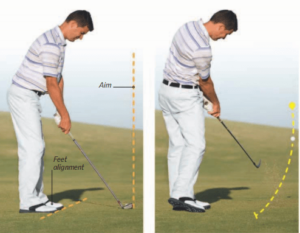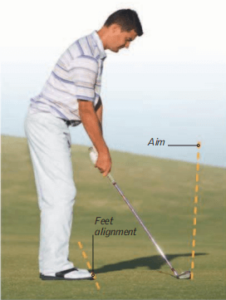Ball flight is determined by the clubhead’s path in the swing and the aim of the clubface relative to this path. This imparts sidespin on the ball, which makes the ball deviate one way or the other.
Controlling these impact factors allows you to shape your shots. The less loft there is on the club, the easier it is to shape the ball.
This is because a relatively straight-faced club, which has little loft, imparts more sidespin than backspin on the ball making it easier to bend the flight of the ball.
A lofted iron creates more backspin and less sidespin, reducing the bend on the ball. Also, you need a good lie to shape a ball. In this article we will discuss how to properly hit a draw and fade. Let’s jump right in.
Table of Contents
How To Hit A Draw
A draw is the perfect shot when the flag is located in the left corner of the green. Aiming straight at the target is risky because there is so little margin for error left of the flag.
But, if you aim to the right of the flag and “draw” the ball in toward the target, the risks are less. If the ball flies straight, you hit middle of the green—no disaster there—and, if the ball draws according to plan, you are looking at a short putt.
For a draw, the ball must be moving from right to left. If you want to swing the ball from right-to-left through the air, align your feet, hips, and shoulders right of the target. The more you want to draw the ball, the farther right you stand. Then aim the clubface straight at the target. Also position the ball a little farther back in your stance than is normal.
Release the club aggressively
A draw requires an aggressive release of the club, whereby the right hand rolls over the left. The alignment of your stance encourages an in-to-out swing path through impact, parallel to the line of your feet.
And, the clubface will be closed to this path at impact, imparting “draw-spin” on the ball.

How To Hit A Fade
A fade is useful when dangers lurk on the right-hand side of the green (a bunker or water hazard, for example) or if the flag is tucked away on the right side.
If the penalty for missing the green on the right side is more severe than missing it on the left, aiming to the left of the flag and playing a fade is the smart shot.
If the stroke goes according to plan, you will finish close to the hole. If you stray slightly one side or other of the perfect line, you will most likely still hit the green.
Even in the worst scenario, the ball will probably land to the left of the green, forcing you to make a straightforward chip onto the putting surface.
In order to hit a fade, the ball must move on a left to right flight path. To make the ball move on a left-to-right flight path, the address position is opposite to that required for a draw. Aim the clubface straight at the target, but align your feet, hips, and shoulders left of the target (essentially, an open stance). Also, position the ball a touch farther forward in your stance at address—just one ball-width more than normal.

For more information on golf stance, see article: How wide should your golf stance be?
Use and open clubface
The path of your swing through impact reflects your alignment, and so the clubhead swings along the line of your feet on an out-to-in path.
The clubface will return to its position at address (open to this swing path), imparting sidespin so that the shot starts left and then fades right.
Related post:



